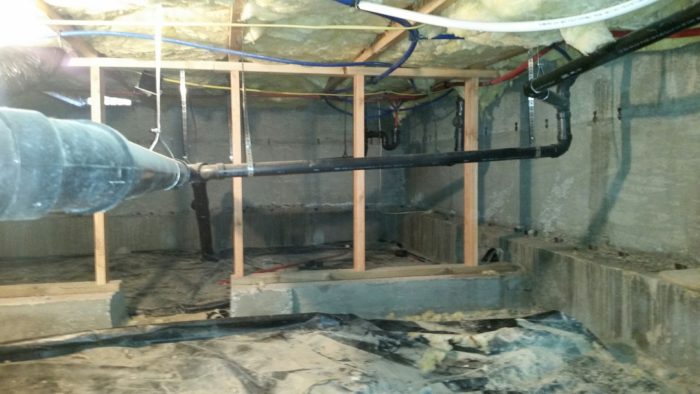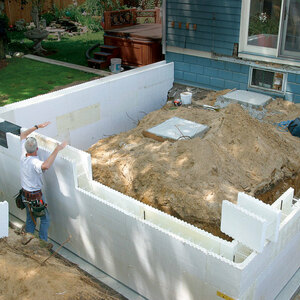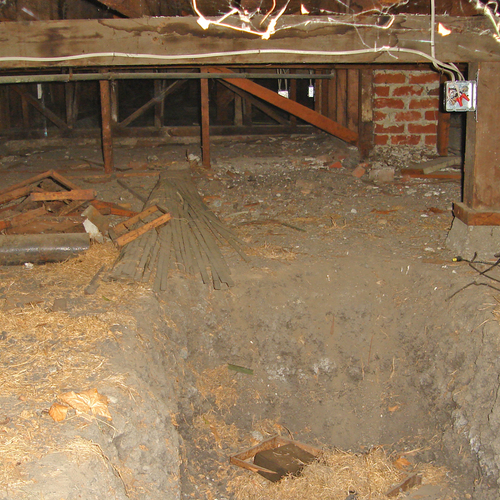
Image Credit: Peter Yost
Michael Geoghegan is designing a house for a mixed, humid climate and he plans on using an insulated crawl space.
Advanced Energy, a regional energy consulting firm, has published a report on crawl spaces which suggests a dehumidifier can be used as an alternative to providing code-required supply air to condition a crawl space. “I’m a little bit concerned about cold floors in the winter time with this method,” Geoghegan writes in a Q&A post at GreenBuildingAdvisor. “Does anyone have any experience here?”
Detailing crawl spaces correctly isn’t simple. A recent Q&A Spotlight focused on methods for insulating a crawl space, and Geoghegan’s question — “What’s the best way of ventilating a sealed crawl space?” — raises overlapping concerns.
In this Q&A Spotlight, the discussion quickly turns to a broader issue: Are crawl spaces a good idea in the first place? Although they are common in the southeastern part of the U.S., they are rarely used in the Northeast, where full basements are the norm and crawl spaces are an anomaly. Who’s right?
Crawl spaces need an exchange of air
A dehumidifier might be useful for lowering humidity levels in a crawl space temporarily, says GBA senior editor Martin Holladay, but there should be no need to for a dehumidifier to become a permanent crawl space fixture. Because dehumidifiers use a lot of energy, it would be better to remove the dehumidifier once the crawl space has dried out.
Long-range, the question becomes how best to comply with a building code requirement that a sealed crawl space be conditioned. There are two code-approved approaches, Holladay says. Both approaches require the installation of a floor grille to connect the crawl space air with the conditioned home above the crawl…
Weekly Newsletter
Get building science and energy efficiency advice, plus special offers, in your inbox.

This article is only available to GBA Prime Members
Sign up for a free trial and get instant access to this article as well as GBA’s complete library of premium articles and construction details.
Start Free TrialAlready a member? Log in















9 Comments
What about the critters?
I am NOT a fan of crawlspaces for many of the reasons highlighted here but one of my pet peeves was not mentioned here. It's the creepy crawly & slithery critters that crawl spaces invite. In my area, it's mostly slab on grade but a few homes have crawlspaces and they are a nightmare when it comes to dealing with black widows, scorpions, rattlesnakes, pack rats, centipedes and whatever other creature wishes to call the crawlspace its domain. Good luck to the poor sap who one day has to venture into that dungeon of horror known as the crawlspace. The pack rats will love to gnaw on your HVAC and plumbing lines and wreak havoc on the homes mechanical. They have even been known to chew their way into the homes floor and make residence inside of the interior. How lovely.
Yes, I am bias towards crawlspaces for all the energy reasons described in this article plus the fact they attract these deadly insects and creatures. Not to mention, crawlspaces got a bad reputation when serial killers used them as a place to bury the bodies of their victims. So to say that crawlspaces are the favored foundation system of deadly venomous creatures and serial killers would be far-reaching but that's my take on them. I'm just saying...
Crawlspaces are Cheaper
Down south, crawlspaces are simply cheaper, usually formed from piers with concrete bases. Little site grading is needed, utilities are easily installed and duct work is probably in the attic.
Critters?
No critters in our clean, dry, conditioned crawlspaces. No snakes, no mice, no camel crickets, no centipedes, no spiders. Though from time to time you'll find a rather cheerful service tech in spotless overalls.
Future changes
For ease of maintenance, and future renovations or additions, a house on a crawlspace with a trussed roof is best. They should be built as short basements and as part of the conditioned space. But unlike basements their height precludes owners from finishing them, hiding the utilities and creating below grade living space where it is vulnerable to moisture problems. Crawlspaces have their place.
Sealed Conditioned Crawl Spaces
The house here in the Colorado Rockies next to the Continental Divide uses a sealed, conditioned crawl space, and it works well in the local environment. Although some builders use basements, and others slabs in this town, there are irrigated fields on each side of the subdivision, so using crawl spaces minimizes potential water leakage problems relative to full basements. There are zero critters in the crawl space as it is a SEALED crawl space, plus there are not many bugs in this cool environment.
The crawl space becomes an excellent place to put HVAC equipment, keeping it in conditioned space. It also allows good clean access to the HVAC equipment, as well as wiring, water supplies, and plumbing. Ventilation is provided by a heat recovery ventilation (HRV) system, with two stale air pickups at opposite ends of the crawl space, with the fresh air from the HRV ducted into the forced hot air ducts downstream of the furnace. Four floor grilles located on the four sides of the house provide conditioned airflow into the crawl space, with the pressure difference generated by the HRV. In this dry climate, there are no moisture problems. It seems like a good approach for the local environment here.
Full basements in New England?
I moved to New England 15 years ago and could not for the life of me figure out the rationale for having basements in this region, it's pure insanity. In my Massachusetts town we regularly have neighbors with flooded basements or dampness problems (sump pumps, ad nauseam), and the ensuing thousands of dollars of equipment and house damage.
I built our house about six years ago, with a crawl space that has stayed pleasantly dry and is without critters. I originally had air vents, but after a year sealed them off because I found the space stayed less humid without them. The floor is covered with gravel with vinyl tarp over this. There's no dampness, no mold.
I'm noticing that builders are more and more going with crawl spaces in this region. Basements are expensive, and the perceived gains include risks. I suspect basements are a holdover from the damp cellar days, where such underground spaces were used to store foodstuffs (a "potato cellar"). It's time to kill this New England tradition.
Reply to Roger
Over the last year or so we had catastrophic floods in a number of communities here in Canada. The worse occurred in High River, Alberta. You would think based in the name alone the residents might have taken some precautions, but the subdivisions were all built with the same designs used elsewhere: A ground floor several feet above grade and full basements finished as living areas. The news showed house after house where the main floor was well above the flooding but residents suffered huge losses as the water filled the below grade spaces. I'm sure there are, a Jin said, places where basements make sense, but I'm with you in that it's a risk I'd rather not take.
I think the most telling
I think the most telling comments are those that equate the choice with cost - crawl spaces are chosen when they are "comfortable" (i.e. used traditionally) and when they result in less cost. Otherwise, it's hard to see the attraction. No doubt the subs like it - easy to run services and they don;t have to live there ("We cashed your check. Thanks!")
I have owned houses with earth-floored crawl spaces, on slab and with full basements. Obviously, in a flood-prone area, a house on stilts would make more sense (or even better - off the flood plain). But a crawl space is just a hassle anywhere with humidity, IMHO. It will be cooler, and it will condense moisture. You can pay t heat that out, dehumidify it or "condition" it, but you will pay, or pay with damage.
Critters are a lesser problem but I was in a friend's new-build crawl space in NJ last summer - what is it with the camel crickets? There must have been 50,000 of them in 500 sq. ft. Weird.
Reply to Roger
Basements in New England were originally popular because they can be easily maintained at temperatures near 40 degrees F and relative humidity near 90 % ideal for long term storage of apples, vegetables and other foods. Then they were popular because the boilers and furnaces of gravity flow central heating worked best located below the space being heated. It wasn’t uncommon for a portion of the house to be on an unvented crawl space or for the headroom of the cellar to be low enough to be considered a crawlspace by many. Soon after the widespread availability of forced heating systems made basements unnecessary, the FHA set construction loan standards requiring ventilation for crawl spaces but exempting basements. Builders likely knew the foolishness of venting in this climate but gave up crawls spaces and continued building basements whenever possible rather than fight the feds. The building code orgs. follow the FHA’s lead with common sense ventilation and vapor barrier requirements. Of course water vapor follows the laws of physics, not common sense. The code provisions actually do work in the southwest where with the combination of warm ground and dry air the ground is the primary source of crawlspace humidity and vents allow it to escape into drier air. People build a few houses on crawl spaces to code out of necessity or the naïve belief they are good building practice, but many of the homes end up with mold, rot, frozen pipes, and cold floors. Instead of prompting code changes the problems just made crawlspaces unpopular.
As to the original question about using a dehumidifier to meet ventilation requirements in a crawl space. The option for conditioned air supply would allow a dehumidifier as the code defines conditioned air as “air treated to control its temperature, relative humidity or quality.“ A humidity control system controlled by a dehumidistat in the crawl space is a big plus over a ventilation system whose effectiveness is dependent on the ac system being set up in a manner and used enough to adequately control humidity. If the paths of moisture entry are controlled, even the smallest portable dehumidifier is overkill. Although humidity can be controlled without a dehumidifier in cool moist climates one would be a better way to appease inspectors than installing ventilation that tends to increase humidity. Unfortunately following code to the letter would require a ducted whole house type with a return path through the living area. They’re energy hogs when windows are used for cooling and fresh air.
There should be no need to regularly supply fresh air to a crawl space. Fresh air requirements are based on the principal that spaces only need ventilation when occupied by people. Only PETA should be concerned about the air quality of vermin in the crawl space; but there should be any pests if it’s closed up anyway. On the rare occasion someone is doing work in the crawl space it would be good to have a second hatch, for both access and ventilation. Where soil-gas issues exist they are better addressed with sub-membrane depressurization or a wide open pier type foundation than a minimally vented crawl space.
I wish supposed experts would stop perpetuating the myths that dead air causes mold and fresh air needs to be circulated though crawl spaces to prevent fungal problems. These myths have caused more damage to buildings than they have prevented, and largely kept a high quality and affordable foundation system out of the northern half of the country.
Another stray thought. When using a forced air ac system for conditioned air supply, you want to deliver warm dry air to the crawl space not cool dry air. Warming surfaces of concern to at least little above the dew point is an important component of moisture control. Better drying could be achieved by supplying air from a grate near the ceiling and transfer duct to the crawl space with a return duct from the crawl space to the air handler. Such a setup could also be sized up to warm the floors in winter without over cooling the crawl space in summer.
Log in or become a member to post a comment.
Sign up Log in